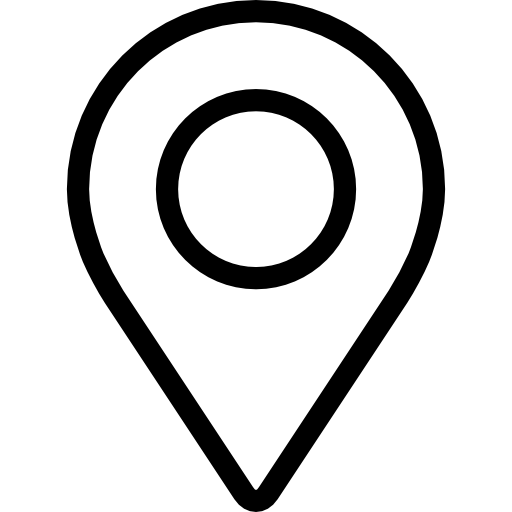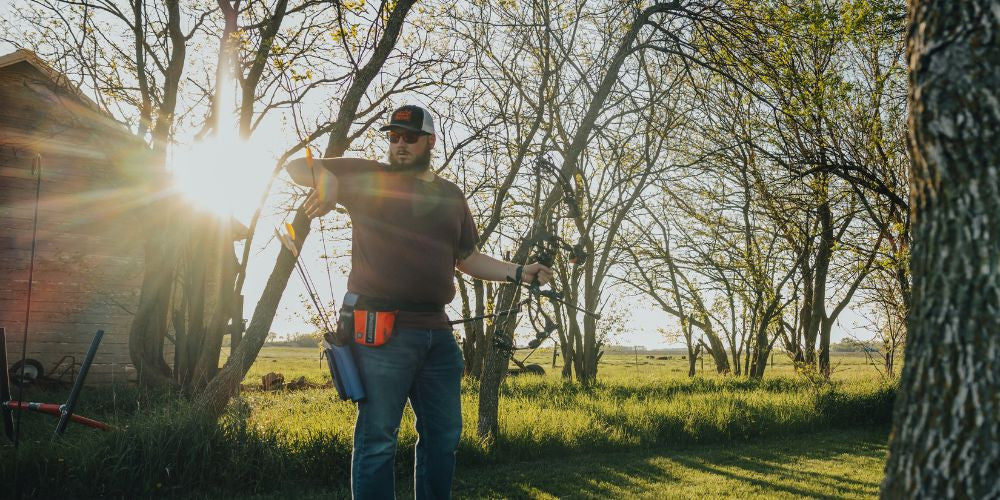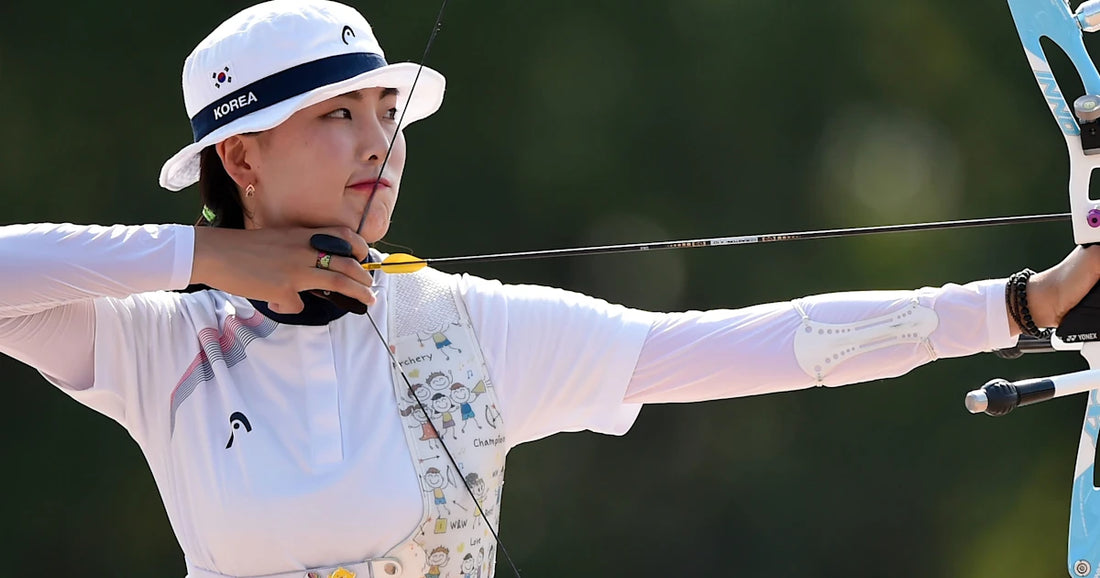An anchor point is a consistent point on the archer's face or body that is used to aim and release the arrow accurately. It is an essential part of the shooting process because it facilitates consistent shooting by ensuring that the arrow is released from the same position every time, resulting in consistent accuracy.
Why are Anchor Points Essential in Archery?
Anchor points are essential in archery for several reasons. First, they provide a reference point for the archer to aim and release the arrow accurately. Second, they help the archer maintain consistent form and technique. Third, a consistent anchor point can help improve the archer's accuracy and consistency over time.
Reference Point for Aiming and Releasing the Arrow Accurately
An anchor point is used as a reference point for aiming and releasing the arrow accurately. When the archer draws the bowstring back to the anchor position, they can align the bow sight and focus on the target. The anchor point ensures that the archer aims at the same spot every time, resulting in consistent accuracy.
Helps Maintain Consistent Form and Technique
As mentioned earlier, an anchor point helps the archer maintain consistent form and technique. By using the same anchor position every time, the archer can ensure that their bow hand, release, and body positioning are consistent. Consistency is critical in archery, as even minor variations can lead to bad form and significantly affect accuracy.
Improves Accuracy and Consistency Over Time
Using a consistent anchor point can help improve an archer's accuracy and consistency over time. By practicing and maintaining a consistent anchor point, the archer can develop muscle memory, making it easier to repeat the same form and technique each time they shoot. Consistency is crucial in archery, and a reliable anchor point can help archers hit their intended target more consistently and achieve better accuracy with their shots.
The Common Archery Anchor Points
Each archer may have slightly different anchor points depending on their individual anatomy and shooting style. Let's delve deeper into some of the common anchor points and discuss the advantages and disadvantages of each.
Chin

The chin anchor point is one of the most popular anchor points used in archery. When using this anchor point, the archer places the tip of their nose on the string and draws the bowstring back until it touches their chin. This anchor point allows the archer to maintain a consistent head position, which can improve accuracy and consistency.
One disadvantage of the chin anchor point is that it can put a strain on the neck and jaw, especially if the archer has a longer draw length. It can also be challenging to maintain a consistent anchor point if the archer's chin moves or if they have facial hair that interferes with the string.
Corner of the Mouth

The corner of the mouth anchor point is another popular choice for archers. To use this anchor point, the archer places the tip of their nose on the string and draws the bowstring back until their index finger touches the corner of their mouth. Archers who use this option reference the corner of their mouth with their index finger while at full draw. This anchor point allows the archer to maintain a relaxed jaw and neck, which can reduce strain and tension.
One disadvantage of the corner of the mouth anchor point is that it can be difficult to maintain a consistent anchor point, especially if the archer's lips are dry or if they have facial hair that interferes with the string. It can also be challenging to maintain a consistent head position while using this anchor point.
Cheekbone

The cheekbone anchor point involves placing the tip of the nose on the string and drawing the bow string back until it touches the archer's cheekbone. This is a good anchor point for archers who have difficulty finding a consistent anchor point elsewhere on their face or who have a shorter draw length. It is also one of the few anchor points <compound bow archers seem to prefer.
One advantage that makes it a common anchor point is that it can be comfortable and easy to maintain a consistent anchor point. However, it can be challenging to use this anchor point if the archer has a longer draw length.
Eye
Using the eye as an anchor point involves placing the tip of the nose on the string and drawing the bow string back until it touches the archer's dominant eye. This anchor point can help ensure that the archer is looking directly down the arrow, which can improve accuracy.
One disadvantage of the eye anchor point is that it can be challenging to maintain a consistent head position while using this anchor point. It can also be difficult to use this anchor point if the archer wears glasses or has difficulty seeing the target clearly.
Back of the Neck
Using the back of the neck as an anchor point involves placing the tip of the nose on the string and drawing the bow string back until it touches the back of the archer's neck. This anchor point can be comfortable, and easy to maintain a consistent position for some archers.
One disadvantage of the back of the neck anchor point is that it can be difficult to use if the archer has a shorter draw length. It can also be challenging to maintain a consistent head position while using this anchor point.
Collarbone
Using the collarbone as an anchor point involves placing the tip of the nose on the string and drawing the bowstring back until it touches the archer's collarbone. This anchor point can be helpful for archers who have difficulty finding a consistent anchor point elsewhere on their face or who have a longer draw length.
One disadvantage of the collarbone anchor point is that it can be uncomfortable or difficult to maintain a consistent anchor point for some archers. It can also be challenging to use this anchor point if the archer has a larger chest or if they are wearing heavy clothing that interferes with the string.
Temple
Using the temple as an anchor point involves placing the tip of the nose on the string and drawing the bowstring back until it touches the archer's temple. This anchor point can be helpful for archers who have difficulty finding a consistent anchor point elsewhere on their face or who have a shorter draw length.
One disadvantage of the temple anchor point is that it can be uncomfortable or difficult to maintain a consistent anchor point for some archers. It can also be challenging to use this anchor point if the archer has a longer draw length or if they wear glasses.
How to Find Your Anchor Point in Archery
Finding your anchor point in archery is an important step in improving your accuracy and consistency. There are several methods to find your anchor point, and each archer may have a different technique that works best for them. However, here are the general steps to find your perfect anchor point:
Determine Your Dominant Eye

Your dominant eye is the one that your brain relies on more heavily for visual input. To determine your dominant eye, make a small triangle with your fingers and hold it up to an object across the room. Close one eye and then the other. The eye that keeps the object in the triangle is your dominant eye.
Adjust Your Bowstring and Sight
Before you start experimenting with different anchor points, make sure your bowstring and sight are properly adjusted. The bowstring should be adjusted so that it is snug against your face but not pressing too hard. The sight should be adjusted to the appropriate distance and height for your shooting style and stance.
Start with a Basic Anchor Point
Start by placing the tip of your nose or the corner of your mouth on the string. This is a basic anchor point that many archers use. Draw the bowstring back to your cheek and take aim. Release the bowstring and observe where the arrow lands. If it is consistently off target, you may need to adjust your anchor point.
Experiment with Small Adjustments
Make small adjustments to your anchor point by moving it slightly up, down, or to the side until you find a comfortable and consistent point of contact. Pay attention to the feel of the contact point and how it affects your accuracy and consistency. Take note of the position of your elbow, wrist, and fingers as well, as these can also affect your anchor point.
Experiment with Different Anchor Points
Try multiple anchor points until you find one that feels comfortable and consistent for you. Some archers use their cheekbone, jawline, or the corner of their mouth as their anchor points. Others may use the tip of their nose or their chin. Experiment with different anchor points to find the one that works best for you.
Practice Consistently
Once you have found your right anchor point, practice consistently to develop muscle memory and improve your accuracy. Practice shooting at various distances and in different conditions to become comfortable and confident with your anchor point.
Tips for Maintaining a Consistent Anchor Point in Archery
Asides from finding a good anchor point, maintaining a consistent anchor point is crucial in archery, as it ensures consistent accuracy and form. Here are some tips to help you maintain a consistent anchor point:
Use a Kisser Button or Peep Sight

Using a kisser button or peep sight can help you maintain a consistent anchor point. A kisser button is a small device that attaches to the bowstring and touches your lips or cheek when you draw the bowstring back. A peep sight is a small ring that attaches to the bowstring and aligns with a sight on the bow. Using either of these devices can help you ensure that you reach the same anchor point each time you shoot.
Check Your Form
Regularly checking your form can help you maintain a consistent anchor point. Make sure that your elbow, wrist, and fingers are all in the correct position and that you are not straining or tensing any muscles. Your shoulders should be relaxed and level and your head should be upright and not tilted to one side.
Use a Mirror or Video Feedback
Using a mirror or video feedback can help you identify any inconsistencies in your anchor point. Set up a mirror or record yourself shooting and observe your form and anchor point. Look for any variations or deviations from your consistent anchor point, and make adjustments as necessary.
Practice with a Coach or Experienced Archer
Practicing with a coach or experienced archer can provide valuable feedback on your form and anchor point. They can observe your shooting and offer suggestions for improvement. They can also help you troubleshoot any issues you may be having with maintaining a consistent anchor point.
Conclusion
Finding and maintaining a consistent anchor point is crucial for accuracy and consistency in archery. It may take some experimentation with multiple anchor points and practice to find the right anchor point for each individual, but the benefits of a consistent anchor point are well worth the effort. By following the steps outlined above and practicing consistently, archers can improve their accuracy and form and become more confident and successful in their shooting.
 cust@legendarchery.com
cust@legendarchery.com 302 503 5767
302 503 5767 Whitestown, In 47075
Whitestown, In 47075




